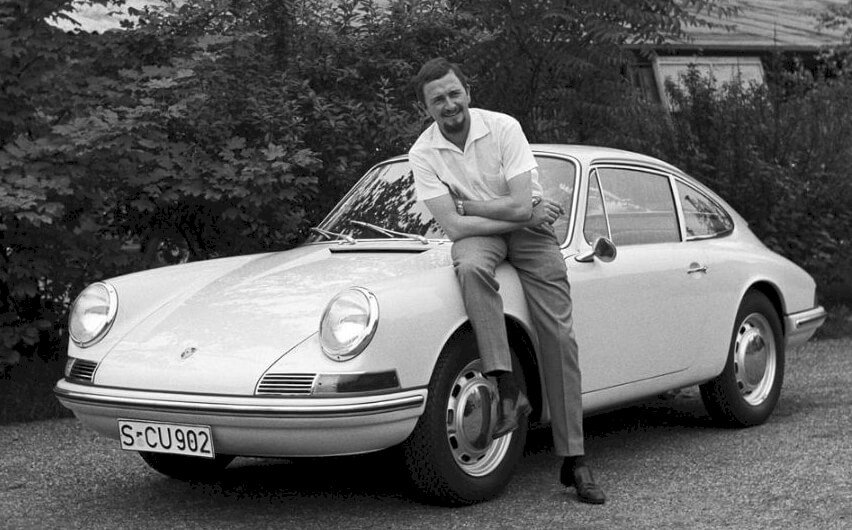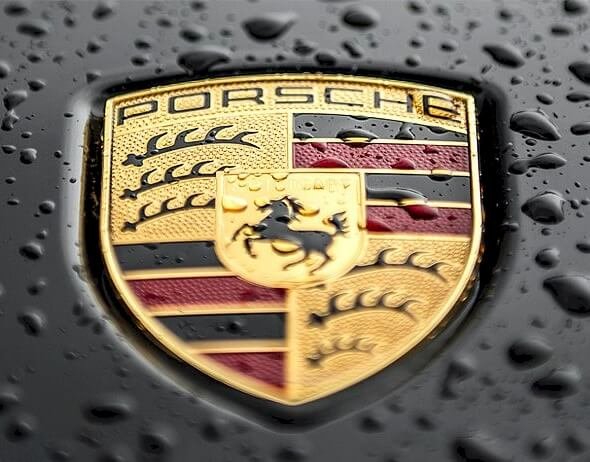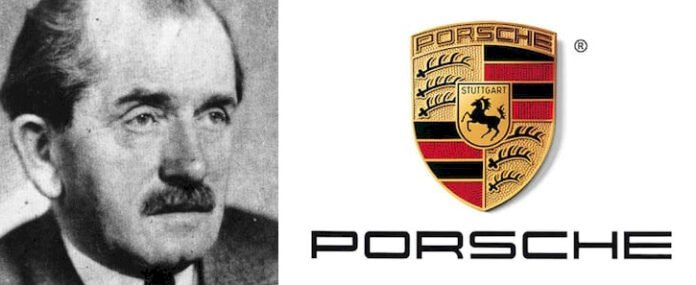Luxurious features and high-performance engines are some of the qualities associated with all Porsche models, and, of course, all of them sport the famous Porsche name and logo. The Porsche logo is iconic and has stayed the same throughout its 60-year history.
The Porsche emblem pays tribute to Stuttgart, the headquarters of Porsche. Stuttgart is a city in the southern part of Germany and was built on a horse-breeding farm. The city’s crest used horses, inspiring Porsche to have a black horse as the focal point of its emblem, which symbolizes the seal and power of Stuttgart.
The Porsche logo is red, black stripes and antlers that were inspired by Württemberg’s state crest since the state’s colors are black and red. The Porsche emblem design also paid homage to Swabia, where the Porsche family also lived.
While not everyone agrees with the story of how the Porsche logo was created, Americans believe that Ferry Porsche (founder Ferdinand Porsche’s son) drew the logo design on a napkin while having a meal with American Porsche distributor Max Hoffman. On the other hand, Germans claim that the logo was designed by an engineer named Xaver Reimpiess.
Regardless of the origins, the classic Porsche emblem was launched in the American market in 1952. It has gone on to become a world-wide recognized emblem for power and luxury in the automotive industry.
The Porsche Logo Evolution

The Porsche symbol was launched in 1952 and has remained the same for the most part since it had all the Porsche brand needed—grace, memorability, and uniqueness.
1952-1963
The Porsche logo we all know today consists of a goldcrest made up of four sections and a smaller crest at the center. The upper section of the prominent crest has the wordmark “Porsche” written in a modern black sans-serif font.
The four sections of the crest have two different adornments: the bottom left, and upper right sections have black and burgundy stripes on them, while the bottom right and upper left segments each have three antlers. These adornments are all inspired by Wurttemberg heraldry.
The smaller crest at the center of the main crest portrays a black horse below a delicate “Stuttgart” wordmark written in a sans-serif font.
1963-Present
In 1963, a modernized version of the original logo appeared. It was the right move since Porsche churned out progressive products that needed a symbol that would keep up with the high technologies of the time.
The new design was a shield with a narrowed bottom and 3D elements. Yellow was replaced by gold, and the black horse acquired elegant features. In addition, bright red stripes replaced burgundy ones. The smaller central crest was trimmed with a slender black line, while the upper section of the main crest was arched.
The Porsche Logo Design Elements

Font: The “Porsche” wordmark placed in the top part of the crest has always played a critical role. The sans serif font has gone through significant changes, but the distinctiveness of the characters has remained largely the same.
The gold wordmark was turned into black in 1994. On the one hand, this made the logo appear more democratic because “gold” was replaced by “steel .” In addition, such a combination drew attention to the black text on a gold background.
Color: The red in the Porsche logo has had different shades over the years. In 1954, the crest had a red tint, which turned orange and then violet in 1963 and 1973. For instance, in 1994, gold lines were added between the black and red stripes, making the emblem well-defined and sharp-cut.
The History of Porsche
Committed to high track performance, German-made Porsche is an iconic brand in the automotive industry. With an institution built on power, speed, performance, family, and emotion, Porsche and its classic models such as Porsche 911 are timeless and have prompted many buyers to learn the history of Porsche and its models. Here’s how the brand started out.
Porsche Origins

Ferdinand Porsche founded the Porsche brand with Anton Piëch and Adolf Rosenberger in 1931. The headquarters of the company were in central Stuttgart, and the company initially offered consulting and development work but didn’t manufacture vehicles under their own brand name.
Intriguingly, one of Porsche’s first jobs as a newly incorporated company was to develop a people’s vehicle dubbed a “Volkswagen .” The Volkswagen Beetle was designed as a result and is regarded as one of the world’s most successful automobile designs of all time.
During World War II, Volkswagen production switched to the military variant of the Beetle, manufacturing 52,000 cars. Porsche created heavy tank designs during the same period, but both contracts were ultimately awarded to Henschel & Son. Towards the end of World War II, Porsche also designed the Maus mega-heavy tank, producing two trial products.
Once World War II ended, Ferdinand Porsche was replaced as head of Volkswagen’s Board of Directors by Ivan Hirst. In 1945, Ferdinand was detained for war crimes but was never taken to court. He spent 20 months in jail, and during this period, his son Ferry decided to make his own car.
As a result, the first model named 356 was made in Austria. When pre-orders hit their targeted production threshold, manufacturing started. This project was undertaken by Porsche Konstruktionen Gesmb, a company that Ferry and his sister Louise had founded.
The 356 is widely seen as the first Porsche model to be built since it was the first car that the company sold.
The Porsche 911
While Porsche enjoyed some motor racing success thanks to the 550 Spyder, the 356 badly needed a major redesign. Therefore, the Porsche 911 was launched by the company in 1964. It came with a 6-cylinder “boxer” engine, with the design overseen by Ferdinand Porsche, Ferry Porsche’s first son.
The Porsche 911 is now one of the most successful and iconic models and has always been among the most successful in motor racing, in road vehicle sales, and rallies. The 911 has gone through many different remodels, and the present model only has the same basic styling cues and basic mechanical design of the 6-cylinder Coupe with the 356.
Interestingly, Porsche changed all the internal codes of its models, but the Porsche 911 has always been marketed as the 911.
The Porsche Carrera
Porsche owns the Carrera brand. Carrera is the Spanish word for race career. Various Porsche models have used the term, including the 356, then 904, and the 911. The Porsche Carrera GT is another Porsche brand, and it was one of the top sports cars in the 2000s and was ranked the 8th best sports car in history.
Porsche Partnership with Toyota
Porsche signed an MOU with Toyota in 1990. This was intended to help Porsche learn and eventually benefit from the lean manufacturing methods of Toyota, which had made the Japanese carmaker a popular brand worldwide.
In 2004, there were also reports that Toyota was helping Porsche adopt hybrid technology.
The Porsche Boxster
Porsche introduced the Porsche Boxster in 1996. It was a 2-seater, double-door roadster. In 2005, the Porsche Cayman, the fastback Boxster Coupe version, was launched.
The Porsche Boxster became the first roadster to be designed since the creation of the 550 Spyder in 1953. The first Boxster’s design was inspired by the Boxster Concept of 1992. The more powerful second-generation Boxster was introduced in 2005, inspired by the Porsche Carrera GT when it comes to styling. In 2012, the third-generation Porsche Boxster was introduced in Geneva.
The Porsche Cayman derived some aspects from the second and third-generation Porsche Boxster. It’s a rear-wheel drive mid-engine 2-seater sports car and was first introduced as a 2006 model. In 2016, the Porsche718 Cayman and Porsche 718 Boxster were introduced as 2017 models, restoring the 718 tag. The engines of the models were flat-four turbocharged entities. The entry price of the 718 Cayman was lower than a Boxster’s.
The Porsche Cayenne
In 2002, Porsche launched a mid-size deluxe crossover SUV named the Porsche Cayenne. Sales in North America started in 2003, and the Cayenne was the first V8 model built by the company since the 928 models in 1995. In addition, it was Porsche’s first off-road version sports car.
The second-generation Porsche Cayenne was unveiled in Geneva in March 2010. The Cayenne shares the same platform with the Audi Q7 and Volkswagen Touareg, but the company handles all other facets of the design in-house. The second generation was slightly improved upon in 2014 and also received a plug-in hybrid variant.
In 2017, the Porsche Cayenne S Diesel wrote its name in the Guinness Book of World Records after towing the heaviest aircraft in the world. The vehicle pulled a 285-ton Air France Airbus A380 to a 42-meter distance, and this shattered the previous record held by Nissan.
In August 2017, the third-generation Porsche Cayenne was announced online. It was launched as a 2019 version, with all engines turbocharged.
The Porsche Macan
The Porsche Macan is a deluxe crossover SUV that Porsche launched in 2014. It competes with SUVs like the Audi Q5, Range Rover Evoque, and Mercedes-Benz GLC.
The Porsche Macan project was revealed in November 2012, initially as a development project, and was launched the following year at the Tokyo and Los Angeles Motor Shows.
The Porsche Macan has the same platform as the Audi Q5, with the suspension and wheelbase tweaked from the Audi. The exterior, interior, and engine are distinctive to Porsche, though.
Porsche Partnership with Volkswagen
Porsche has always enjoyed a close working relationship with Volkswagen, mainly because it was the former that built the original Volkswagen Beetle.
Porsche collaborated with Volkswagen on the Volkswagen-Porsche 914 and 914-6. While the former came with a Volkswagen engine, the latter boasted a Porsche engine.
Porsche SE and Volkswagen AG signed a deal in 2009, which would see the two companies’ manufacturing operations merged in 2011. They’d then establish a “United Automotive Group.”
In the deal, Volkswagen AG ceded 50.76% of its shares to Porsche SE. In exchange, Volkswagen AG would take over some of the management positions at Porsche SE. This was intended to keep the Volkswagen AG in charge of the firm and buy out Porsche AG.
Porsche and Volkswagen together control Audi, Bentley, Skoda, SEAT, Lamborghini, Bugatti, Ducati, MAN, and Scania.
Porsche Today and Into the Future
The third-generation Porsche Cayenne was launched in the summer of 2018 and was sold as a 2019 version. It came with features such as Porsche’s communication system’s touch screen, smart voice control, as well as a WiFi hotspot.
In March 2017, Porsche launched the Porsche 911, Carrera T, in the United States. The model is focused on performance-boosting features not found on the original Porsche Carrera. It’s also available in 9 exterior colors, including Carrera White, Lava Orange, and Racing Yellow.
Porsche is still manufacturing luxury SUVs and also dominating the high-end sports car market, giving brands like Audi and BMW severe competition. With the company launching more and more models year after year, Porsche is still one of the most marketable automotive brands today.
Summing Up the History of Porsche

Porsche is a renowned German car manufacturer that specializes in high-performing luxury sports cars, sedans, and SUVs. The company was founded by Ferdinand Porsche in 1931 along with Anton Piëch and Adolf Rosenberger, initially, as a car consulting and design business.
Ferdinand Porsche once worked at Mercedes-Benz as the chief engineer and even spent some time designing Volkswagen Vehicles. After starting Porsche in 1931, the company started producing cars that went on to become famous for their top quality and performance.
Porsche started its German operations in 1948 and has been building incredible luxury sports cars and SUVs ever since, not least the famous Porsche 911, which is the longest-produced sports car. The 911 was introduced in 1964, with its 8th generation introduced in 2019.
The headquarters of Porsche is in Stuttgart, Germany. Volkswagen AG owns the Porsche brand, whose present lineup includes the Porsche 911, the Porsche 718 Boxster, the Porsche 718 Cayman, the Porsche Panamera, the Porsche Cayenne, the Porsche Macan, and the Porsche Taycan.







